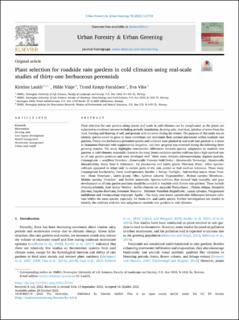| dc.description.abstract | Plant selection for rain gardens along streets and roads in cold climates can be complicated, as the plants are subjected to combined stresses including periodic inundation, de-icing salts, road dust, splashes of water from the road, freezing and thawing of soil, and periods with ice cover during the winter. The purpose of this study was to identify species suited to grow in these conditions and determine their optimal placement within roadside rain gardens. Thirty-one herbaceous perennial species and cultivars were planted in real-scale rain gardens in a street in Drammen (Norway) with supplemental irrigation, and their progress was recorded during the following three growing seasons. The study highlights considerable differences between species’ adaptation to roadside rain gardens in cold climates, especially closest to the road. Some candidate species/cultivars had a high survival rate in all rain garden positions and were developed well. These were: Amsonia tabernaemontana, Baptisia australis, Calamagrostis × acutiflora ‘Overdam’, Hemerocallis ‘Camden Gold Dollar’, Hemerocallis ‘Sovereign’, Hemerocallis lilioasphodelus, Hosta ‘Sum & Substance’, Iris pseudacorus and Liatris spicata ‘Floristan Weiss’. Other species/cultivars appeared to adapt only to certain parts of the rain garden or had medium tolerance. These were: Calamagrostis brachytricha, Carex muskingumensis, Eurybia × herveyi ‘Twilight’, Hakonechloa macra, Hosta ‘Francee’, Hosta ‘Striptease’, Liatris spicata ‘Alba’, Lythrum salicaria ‘Ziegeunerblut’, Molinia caerulea ‘Moorhexe’, Molinia caerulea ‘Overdam’, and Sesleria autumnalis. Species/cultivars that showed high mortality and poor development at all rain garden positions should be avoided in roadside cold climate rain gardens. These include Amsonia orientalis, Aster incisus ‘Madiva’, Astilbe chinensis var. tacquettii ‘Purpurlanze’, Chelone obliqua, Dryopteris filix-mas, Eurybia divaricata, Geranium ‘Rozanne’, Helenium ‘Pumilum Magnificum’, Luzula sylvatica, Polygonatum multiflorum and Veronicastrum virginicum ‘Apollo’. The study also found considerable differences between cultivars within the same species, especially for Hosta cvv. and Liatris spicata. Further investigations are needed to identify the cultivars with the best adaption to roadside rain gardens in cold climates. | |
